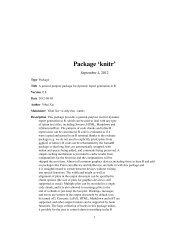Package 'openair'
Package 'openair'
Package 'openair'
You also want an ePaper? Increase the reach of your titles
YUMPU automatically turns print PDFs into web optimized ePapers that Google loves.
14 conditionalEvalon to cutData to provide southern (rather than default northern) hemispherehandling of type = "season". Similarly, common axis and title labelling options(such as xlab, ylab, main) are passed to xyplot via quickText to handleroutine formatting.DetailsThe conditionalEval function provides information on how other variables vary across the sameintervals as shown on the conditional quantile plot. There are two types of variable that can beconsidered by setting the value of statistic. First, statistic can be another variable in the dataframe. In this case the plot will show the different proportions of statistic across the range ofpredictions. For example statistic = "season" will show for each interval of mod the proportionof predictions that were spring, summer, autumn or winter. This is useful because if model performanceis worse for example at high concentrations of mod then knowing that these tend to occurduring a particular season etc. can be very helpful when trying to understand why a model fails.See cutData for more details on the types of variable that can be statistic. Another examplewould be statistic = "ws" (if wind speed were available in the data frame), which would thensplit wind speed into four quantiles and plot the proportions of each.Second, conditionalEval can simultaneously plot the model performance of other observed/predictedvariable pairs according to different model evaluation statistics. These statistics derive from themodStats function and include "MB", "NMB", "r", "IOA", "MGE", "NMGE", "RMSE" and "FAC2".More than one statistic can be supplied e.g. statistic = c("NMB", "IOA"). Bootstrap samplesare taken from the corresponding values of other variables to be plotted and their statisticswith 95% confidence intervals calculated. In this case, the model performance of other variables isshown across the same intervals of mod, rather than just the values of single variables. In this secondcase the model would need to provide observed/predicted pairs of other variables.For example, a model may provide predictions of NOx and wind speed (for which there are also observationsavailable). The conditionalEval function will show how well these other variables arepredicted for the same intervals of the main variables assessed in the conditional quantile e.g. ozone.In this case, values are supplied to var.obs (observed values for other variables) and var.mod (modelledvalues for other variables). For example, to consider how well the model predicts NOx andwind speed var.obs = c("nox.obs", "ws.obs") and var.obs = c("nox.mod", "ws.mod")would be supplied (assuming nox.obs, nox.mod, ws.obs, ws.mod are present in the data frame).The analysis could show for example, when ozone concentrations are under-predicted, the modelmay also be shown to over-predict concentrations of NOx at the same time, or under-predict windspeeds. Such information can thus help identify the underlying causes of poor model performance.For example, an under-prediction in wind speed could result in higher surface NOx concentrationsand lower ozone concentrations. Similarly if wind speed predictions were good and NOx was overpredicted it might suggest an over-estimate of NOx emissions. One or more additional variablescan be plotted.A special case is statistic = "cluster". In this case a data frame is provided that contains thecluster calculated by trajCluster and importTraj. Alternatively users could supply their ownpre-calculated clusters. These calculations can be very useful in showing whether certain backtrajectory clusters are associated with poor (or good) model performance. Note that in the case ofstatistic = "cluster" there will be fewer data points used in the analysis compared with theordinary statistics above because the trajectories are available for every three hours. Also note thatstatistic = "cluster" cannot be used together with the ordinary model evaluation statistics
















